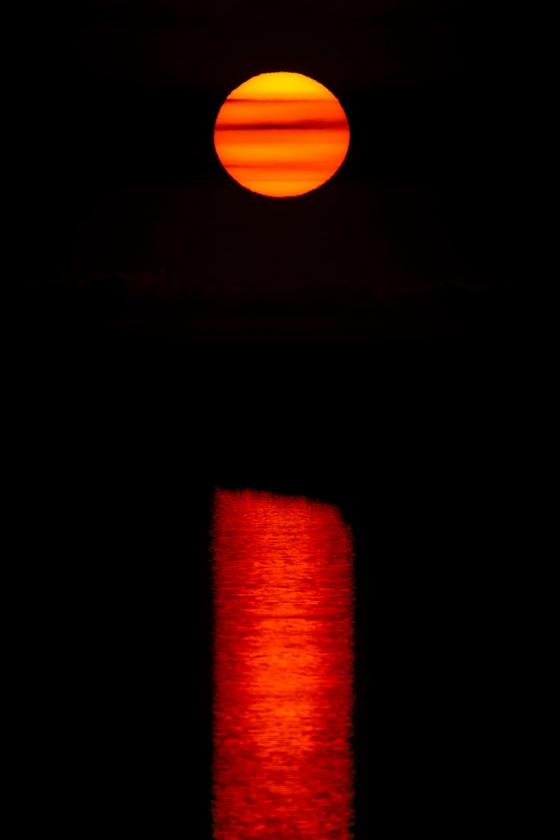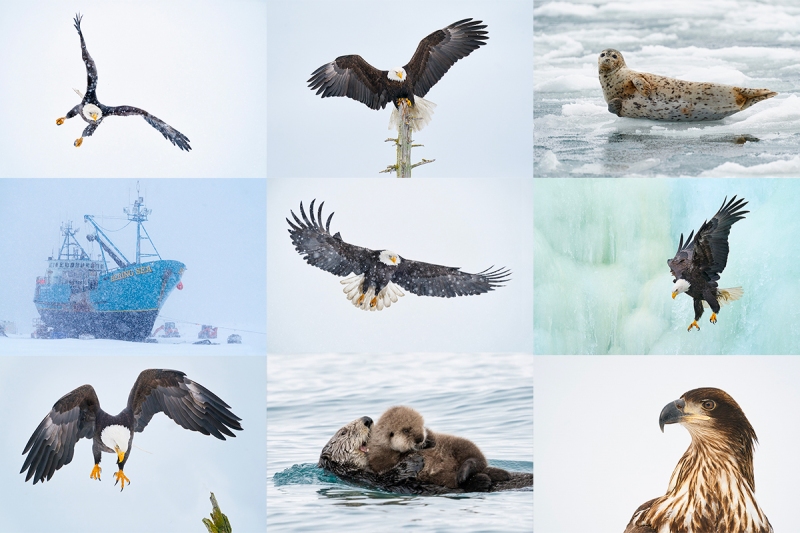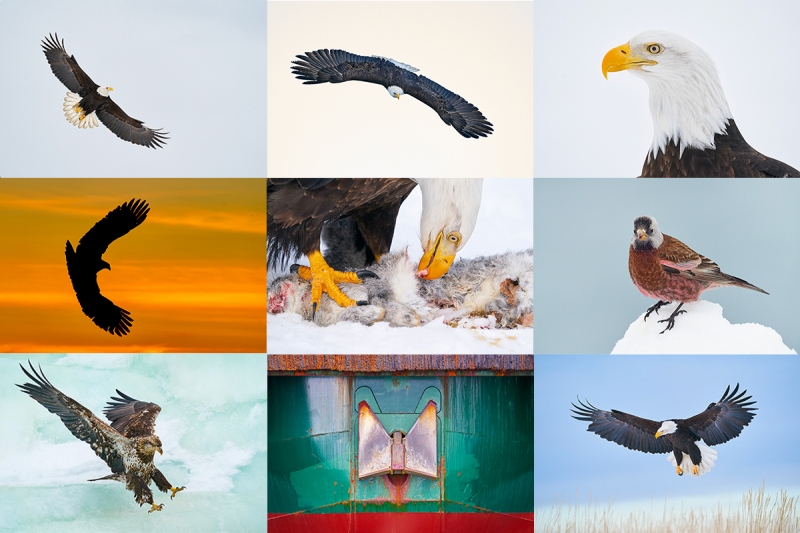What’s Up?
I was, very early on Thursday. But with some violent thunderstorms forecast for the areas around Okefenokee Swamp, I decided to stay in and work on my upcoming programs rather than have no nap in the middle of an 18-hour day … My workflow program went very well despite an hour-long blackout. I made two Camtasia videos — one of picking your keepers and another of the image processing we did. Once I upload them, the links will be e-mailed to the participants. With a strong west/northwest wind and clear skies after a big storm, conditions were perfect for the afternoon bird photography workshop to Jekyll Point. But very few birds showed up. Nonetheless, the boys and girls learned a ton as we worked a small flock of Royal Terns sitting on a clean sand beach. We did have some flying in and out. Amazingly, there were very few Laughing Gulls. The storm was surely the culprit. We stayed late on the beach and created some soup-from-a-stone images of sparkling golden sand patterns and zig zag tidal pool sunset scenic silhouettes.
Thanks to the many who commented on the Gorgeous or Garbage question in yesterday’s blog post.
Today is Friday 8 April 2022. I will be doing my first GNPA keynote program at 10:00am. It is entitled A Bird Photographer’s Story. I have done it many times over the past 15 years. This latest version features about 200 new images, all of which were among my recently recovered images. Wherever you are and whatever you are doing, I hope that you too have a great day. This blog post took about an hour to prepare and makes twenty-eight days in a row with a new one.
Please remember to use the B&H and Amazon links that are found on most blog pages and to use the BIRDSASART discount code at checkout when purchasing your new gear from Bedfords. Please, also, consider joining a BAA IPT. You will be amazed at how much you will learn …
|
|
|
This image was created on 5 April 2022 on the way to Harris Neck NWR. I used the hand held Sony FE 200-600mm f/5.6-6.3 G OSS lens (at 600mm) and The One, the Sony Alpha 1 Mirrorless digital camera. ) The exposure was determined using Zebra technology with Exposure Compensation on the Thumb Dial. AUTO ISO set ISO 100. Multi-metering -4 stops: 1/8000 second at f/8 (stopped down 2/3 stop) in Shutter Priority mode. AWB at 7:13:37 (about six minutes after sunrise) with some faint clouds on the eastern horizon. RawDigger showed the exposure to be within 1/3-stop of dead-solid perfect. Tracking: Upper Center Zone AF-C performed perfectly. Be sure to click on the image to enjoy a high-res version. Image #1: The sun and the sun glint swath
|
The Sun Glint Swath
What can I say? I like making up new photo-related words and terms. When I created the “keyhole technique” way back in the times of film, I created a good exposure only by luck. It was called the “keyhole technique” because there was a Great Blue Heron (along with some marsh grasses) in the swath. The caption, on page 73 of the still relevant The Art of Bird Photography, read as follows:
GREAT BLUE HERON AT DAWN, Brigantine National Wildlife Refuge, New Jersey
Canon FR 400mm f/4.5 lens and T-90 body. Kodachrome 64, center-weighted average metering: 1/2000 sec. at f5/6.
Sometimes it pays to experiment. After making a series of images at the “correct exposure (by metering off the sky adjacent to the sun), I made a single image at the metered exposure with the sun in the frame and discovered the “keyhole technique.”
You can create a similar image today with any digital camera body if you understand what is going on and have some understanding of where you are going with the exposure. With most systems, it would take several test images to avoid any blinkies, again, only if you had a clue where to begin. With Sony and a good idea of where to start, I simply switched to S (Tv) mode, began with a very high shutter speed, and dialed down the Exposure Compensation until there were only faint Zebras on the sun. It really was child’s play using Zebra technology.
I’ve been trying to create an image like the great blue keyhole shot for more than 35 years but have never had a bird in the sun glint swath! I guess that it would not be too difficult to put a small, silhouetted bird in there, but I rarely add anything to an image that wasn’t there when I pushed the shutter button.
Note for the exposure-proficient folks: If I had a more advanced camera body that featured evaluative metering the GBH keyhole image would have been grossly over-exposed as the system would have opened up too much upon seeing the blasting sun in the frame …
Yes, the original The Art of Bird Photography (in soft cover and available only from BIRDS AS ART), illustrated with only film images (it was first published in 1998), is somewhat dated. But many of the topics covered have not changed a bit in nearly one-quarter of a century. My life sure did change after it was published. 🙂 The still-relevant topics include Choosing the Right Equipment (to some degree), the Autofocus Advantage (in spades!), Making Good Exposures, On Matters of Light, Producing Sharp Images, Getting Close, and Capturing Action and Behavior. Only two chapters are irrelevant today; Film Choice, and, unfortunately, Evaluating and Selling Your Work.
All in all, eight out of ten ain’t bad. The Making Good Exposures chapter, is, however, worth the price of the book on its own for those serious students who wish to master exposure theory. If you have not mastered the principles detailed in the A Quick Guide to Correct Exposure chart on page 62, you are pretty much hunting in the dark …
Homer 2022 Bald Eagle Highlights and Handholding Compositional Tips by Arthur Morris/BIRDS AS ART
Enjoy and be inspired by just a few Homer Bald Eagle highlight images. Hand holding intermediate telephoto lens will always yield slightly different compositions. Learn more about that topic in this short (3:14) video.
|
|
|
2023 Homer/Kachemak Bay Bald Eagle IPTs
IPT #1: MON 20 FEB 2023 through the full day on FRI 24 FEB 2023. Five full days/20 hours on the boat: $5500.00. Limit 5 photographers
IPT #2: SAT 25 FEB 2023 through the full day on THURS 2 MAR 2023. Six full days/24 hours on the boat: $6600.00. Limit 5 photographers
IPT #3: FRI 3 MAR 2023 through the full day on TUES 7 MAR 2023. Five full days/20 hours on the boat: $5500.00. Limit 5 photographers.
Save $1,000.00 by doing back-to-back trips. Save $1500.00 by doing all three.
This trip features non-stop flight photography as well as many opportunities to create both environmental and point-blank portraits of one of North America’s most sought-after avian subjects: Bald Eagle (Haliaeetus leucocephalus). Other reliable subjects will include Sea Otter, Glaucous-winged and Short-billed (formerly Mew) Gulls.
In addition, we should see Common Murre, Black Guillemot, Pelagic Cormorant, two or three species of loons, and a smattering of ducks including two species of merganser, all three scoters, Common and Barrow’s Goldeneyes, Bufflehead, Harlequin, and Long-tailed Ducks. Close-range photographic chances for these species will require a ton of good luck. Some of these species, especially when in flocks, can, however, often be used effectively when pleasing creating bird-scapes.
If we need to be out early, we will be the first boat out. If conditions are great, we will stay out. And when there is a chance for sunset silhouettes, we will be in the right spot.
We will be traveling through gorgeous wilderness country; landscape and scenic opportunities abound.
Also featured is a professional leader, often referred to as the world’s most knowledgeable bird photography trip leader, who is conversant in Canon, Nikon, and Sony. You will learn practical and creative solutions to everyday photographic problems. You will learn to see the shot, to create dynamic images by fine-tuning your compositions, to best utilize your camera’s AF system, and how to analyze the wind, the sky conditions, and the direction and quality of the light. This is one of the very few trips Homer trips available where you will not be simply put on the birds and told to have fun. You will learn to be a better photographer. But only if that is what you want.
You will learn to get the right exposure when it is sunny, when it cloudy-bright, when it is cloudy, when it is cloudy-dark, or when it is foggy. Not to mention getting the right exposure when creating silhouettes.
You will learn to make pleasing blurs working in manual mode and to create silhouettes working in Shutter Priority mode.
Most importantly you will learn to pick your best flight images from tens of thousands of images.
You will enjoy working with the two best and most creative boat captains on their sturdy, photography-spacious, seaworthy, open-deck crafts.
The second and third IPTs are the only Bald Eagle workshops that feature an incredibly helpful first mate.
Only five photographers (not the usual six), plus the leader.
Small group Photoshop, Image Review, and Image Critiquing sessions.
|
|
All images from Homer or Kachemak Bay, AK |
What’s Included
One four hour or two two-hour boat trips every day (weather permitting), all boat fees and boat-related expenses (excluding tips), ground transportation to and from the dock and back to the hotel each day, in-the-field instruction and guidance, pre-trip gear advice, small group post-processing and image review sessions, and a thank you dinner for all well-behaved participants.
What’s Not Included
Your airfare to and from Homer, AK (via Anchorage), the cost of your room at Land’s End Resort, all personal items, all meals and beverages, and tips for the boat captain and/or the first mate.
Please Note
On great days, the group may wish to photograph for more than four hours. If the total time on the boat exceeds 20 hours for the five-day trips, or 24 hours for the second trip, the group will share the additional expense at a rate of $225/hour.
Some folks may wish to rent their own vehicle to take advantage of local photographic opportunities around Homer.
Deposit Information
A $3000 non-refundable deposit/trip is required. You may pay your deposit with credit card or by personal check (made out to BIRDS AS ART) and sent via US mail only to Arthur Morris. PO Box 7245. Indian Lake Estates, FL 33855. Your balance, due 90 days before the date of departure, is payable only by check as above.
In Closing
I have been going to Homer off and on for close to two decades. Every trip has been nothing short of fantastic. Many folks go in mid-March. The earlier you go, the better the chances for snow. The only way to assure that you are on the best of the three trips is to sign up for all of them. Can you keep up with me? If you have any questions, or are good to go for one, two, or all three trips, please let me know via e-mail or give me a call on my cell phone at 863-221-2372.
Typos
With all blog posts, feel free to e-mail or to leave a comment regarding any typos or errors.

















Love the swath. I have taken many such shots, and for me the difficulty is getting both the sun (or the moon) and the swath exposed properly. I get it right occasionally.
Love these new ideas !